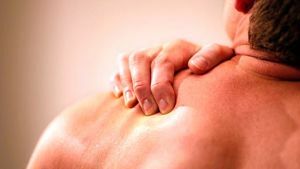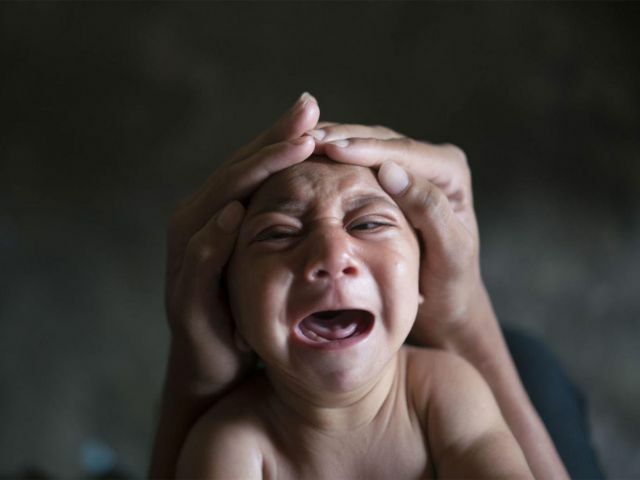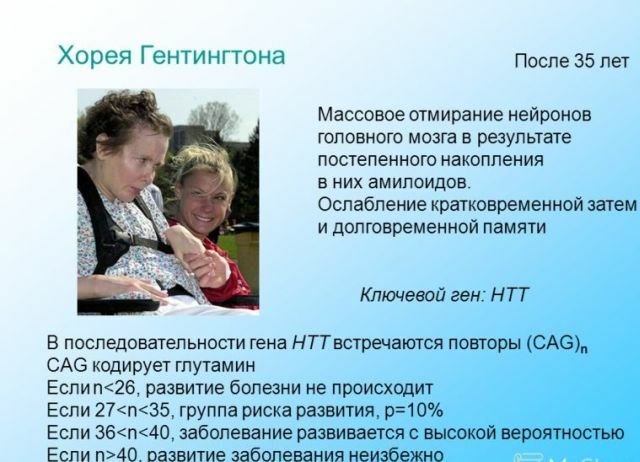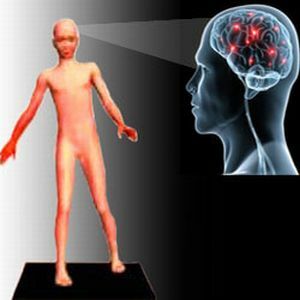 Ataxia is a violation of coordination of movements and motor skills.
Ataxia is a violation of coordination of movements and motor skills.
With such a disease, the strength in the limbs is somewhat reduced or completely preserved. Movements differ in inaccuracy, awkwardness, their consistency is disrupted, it is difficult to maintain balance when walking or standing.
If the balance is broken only in the standing position, they speak of a static ataxia.
If the coordination disorders are noted during the movement, then this ataxia is dynamic.
Contents of
- Ataxia species
- Features of cerebellar ataxia syndrome
- Hereditary ataxia of Pierre Marie
- What causes pathology?
- The disease can not be missed
- Diagnostics
- It is important to start treatment in time!
- Training complex
- Consequences can be the most sad
- Forecast
Ataxia species
There are several types of ataxia:
- Sensitive. The origin of the disorder is caused by the damage to the posterior columns, less often - the hind nerves, peripheral nodes, the cortex of the parietal cerebral lobe, the visual hillock. The disease can occur in all limbs, or only in one arm or leg. The most pronouncedly sensitive ataxia is manifested in the disorder of the joint-muscular sensations in the legs. The patient is characterized by an unstable gait, when walking, he excessively bends his knees or comes too heavily to the floor. Sometimes there is a feeling of walking on the soft surface. Patients compensate for impaired motor function through vision - while walking constantly look under their feet. Serious injuries to the posterior pillars practically deprive the patient of the ability to stand or walk.
- Vestibular. Develops when one of the sections of the vestibular apparatus is affected. The main symptom is system dizziness. It seems to the patient that the surrounding objects move in one direction, when the head turns, this sensation intensifies. The patient avoids sudden movements of the head, can randomly wobble or fall. Vestibular ataxia may cause nausea and vomiting. The disease accompanies stem encephalitis, a fourth brain ventricle, Meniere's syndrome.
- Cortical. Appears when the frontal lobe of the brain is affected by dysfunction of the frontal-bridge system. In this condition, the most affected leg is the opposite to the affected hemisphere. Walking is unstable( especially at bends), slopes or stalling on its side. In severe injury, the patient can not walk and stand. This type of ataxia is also characterized by the following symptoms: impaired sense of smell, changes in the psyche, the appearance of a grasping reflex.
- Cerebellar. With this type of ataxia, the cerebellum, its hemisphere or legs are affected. When walking, the patient falls or falls. When a cerebellar worm is affected, the fall occurs to the side or back. The patient staggers when walking, widely spreads his legs. Movements are characterized by sweeping, sluggishness and awkwardness. Speech function can also be violated - speech becomes slow and stretched. The patient's handwriting is sweeping and uneven. Sometimes there is a decreased muscle tone.
Cerebellar ataxia occurs with encephalitis, multiple sclerosis, malignant tumors.
Features of cerebellar ataxia syndrome
The main difference between cerebellar lesions is , evidence-based hypotension in the atactic limb ( reduced muscle tone).When 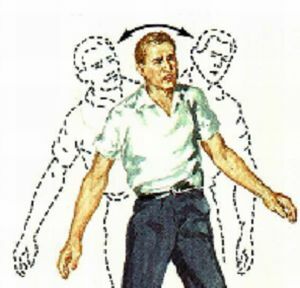 disorders of the cerebellum, the symptomatology is never limited to a specific muscle, a muscle group or a separate movement.
disorders of the cerebellum, the symptomatology is never limited to a specific muscle, a muscle group or a separate movement.
It is inherent in a widespread character.
Cerebellar ataxia has the characteristic symptoms:
- impaired gait and standing;
- impaired limb coordination;
- intentional jitter;
- slow speech with separate pronunciation of words;
- involuntary oscillatory movements of the eyes;
- decreased muscle tone.
Hereditary ataxia of Pierre Marie
Cerebellar ataxia Pierre Marie is a hereditary disease characterized by a progressive nature.
The probability of manifestation of the disease is high - passing of generations is extremely rare. A characteristic pathologoanatomical sign is cerebellar hypoplasia, which is often combined with degeneration of spinal systems.
The disease most often begins to appear at the age of 35 in the form of a violation of gait. Further, it is associated with speech and facial disorders, ataxia of the upper limbs.
Tendon reflexes are increased, involuntary muscular jerks occur. The strength in the extremities decreases, the oculomotor disturbances progress. Disorders of the psyche are manifested in the form of depressions, reducing mental activity.
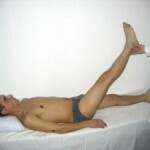 One of the manifestations of cerebellar ataxia is the so-called asinergia of Babinsky - details of the disease in the article.
One of the manifestations of cerebellar ataxia is the so-called asinergia of Babinsky - details of the disease in the article.
What is the peculiarity of the VSD by the hypotonic type - the symptoms and treatment of this type of vegetative-vascular dystonia are discussed here.
What causes pathology?
Causes of the disease may include:
- Intoxication with medications( lithium preparations, antiepileptic drugs, benzodiazepines), toxic substances. The disease is accompanied by drowsiness and confusion.
- A cerebrovascular insult , the early detection of which can save a patient's life. Violation occurs due to thrombosis or embolism of the cerebellar arteries.
- Appears in the form of hemiatoxia and reduction of muscle tone on the affected side, headache, dizziness, impaired mobility of the eyeballs, impaired sensation of the face on the affected side, weakness of facial muscles.
- Cerebellar hemiataxy can be as a consequence of the developing medullar infarction caused by Horner's syndrome.
- Infectious diseases. Cerebellar ataxia often accompanies a viral encephalitis, an abscess of the cerebellum. In childhood, after a viral infection( for example, after chickenpox), acute cerebellar ataxia may develop, which is manifested by a violation of the gait. Such a condition, as a rule, ends with complete recovery within a few months.
In addition, the pathology may be a consequence of:
- craniocerebral trauma;
- brain tumors;
- cerebral palsy;
- Multiple Sclerosis;
- lack of vitamin B12.
Symptoms can not be missed
The main symptom of cerebellar ataxia is static disorders .The characteristic posture of the patient in standing position is widely spaced legs, balancing with hands, avoiding corners and corners of the body.
If the patient is to push or move his leg, he will fall, not even noticing that he is falling.
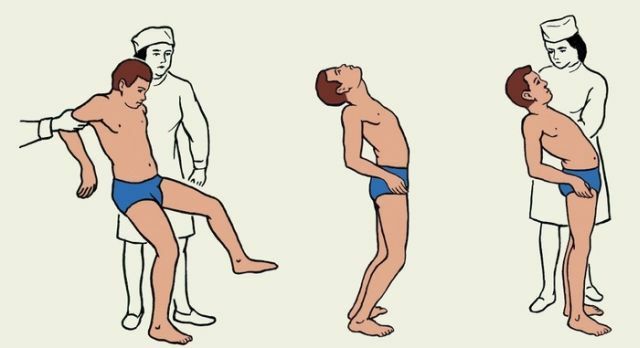
With dynamic disorders, the disease manifests itself in the form of a kind of gait( sometimes called "cerebellar").The legs are wide apart and tense when walking, the patient tries not to bend them.
The body is straight, slightly tilted back. At the corners, the patient falls and sometimes falls. When swapping the legs, a wide swing amplitude is observed.
Over time, adiadochondria manifests itself - the patient can not alternate between movements( for example, alternately touching the tip of the nose with fingers).
The speech function is broken, handwriting worsens, the face acquires mask-like features( due to violation of facial expressions).Such patients are often mistaken for drunken people, because of this, there is no medical assistance at the time.
Patients complain of pain in the legs and arms, lower back, neck. Muscle tone is elevated, convulsive jerks can appear.
Ptosis often occurs, convergent strabismus, dizziness when trying to focus the look. Reduces visual acuity, develops mental disorders and depression.
Diagnostics
When conducting a full complex of examinations, the diagnosis is not difficult.
Requires taking a functional test, evaluation of tendon reflexes, examination of blood and cerebrospinal fluid.
Computer tomography and ultrasound of the brain is prescribed, anamnesis is being prepared.
It's important to start treatment in time!
Cerebellar ataxia is a serious disorder that requires immediate action, treatment is performed by a neurologist.
It is most often symptomatic and covers the following areas:
- general restorative therapy( administration of inhibitors of cholinesterases, Cerebrolysin, B vitamins);
- physiotherapy, the purpose of which is to prevent various complications( muscle atrophy, contracture), improve gait and coordination, support physical fitness.
Training complex
 A gym complex consisting of exercise exercises is prescribed.
A gym complex consisting of exercise exercises is prescribed.
The purpose of training is to reduce discoordination and strengthen muscles.
In surgical treatment( elimination of cerebellar tumors), partial or complete restoration or cessation of the development of the disease can be expected.
If pathology is a consequence of an infectious disease of the nervous system, the treatment of this infection is mandatory. The doctor prescribes drugs that improve cerebral circulation, nootropics, betagistin.
A special massage helps to reduce the severity of the symptoms.
Consequences may be the most sad
Complications of ataxia may be:
- propensity to repeat infectious lesions;
- chronic heart failure;
- respiratory failure.
Forecast
It is impossible to completely cure cerebellar ataxia.
The prognosis is rather unfavorable, since the disease has the property of rapidly progressing .The disease significantly worsens the quality of life and leads to numerous disorders on the part of the organs.
Cerebellar ataxia is a very serious disease. At the first symptoms it is necessary to immediately contact a specialist for the purpose of conducting a comprehensive survey.
If the diagnosis is confirmed, timely action will significantly ease the patient's condition in the future and slow the progression of the disease.

